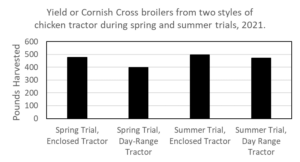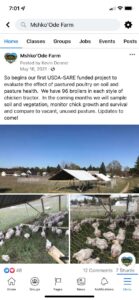Final report for FNC21-1267
Project Information
Mshko'Ode Farm was established in 2018 as a family operation consisting of 33 acres of mostly forested hills. We have 6 acres of open field/pasture which is used for raising poultry, pigs, flowers, market vegetables, and indigenous varieties of corn, beans, and squash. Though not certified, we incorporate organic growing practices across the board. All meats are pasture raised and we do not permit the used of synthetic fertilizers or pest control chemicals. We grow, harvest, and care for the earth in a way that ensures sustainability, improves our relationship with the land, and attempts to achieve 7 generation-type ideals.
Pastured-poultry rearing systems are touted as 1) more environmentally friendly, 2) healthier for poultry, and 3) key to creating a more nutritionally desirable product. However, little scientific work has been completed to determine the validity of these claims, particularly with regard to environmental impacts/benefits and pasture health. Pastured poultry rearing systems are diversifying and almost no work has been completed to evaluate new and emerging systems. We propose to evaluate the effect of mobile pen and day range rearing systems on a fallow, unmanaged pasture. We will determine vegetative species composition, vegetative growth, nutrient profiles, organic matter content in soil before and at several points after pasture is subjected to each rearing system including a control plot. We will further determine the effect of each rearing system and on carcass quality including growth rate and part development. Results will be analyzed to determine profitability and marketing potential of each rearing system.
Project objectives include: 1)Compare the yield and functional utility of two pasture-based poultry rearing systems. 2)Determine the impact of two pasture-based poultry rearing systems on soil health, soil fertility, and pasture vegetation in a fallow, relatively nutrient poor field 3)Share findings with local farmers, local land managers, on social media, and with the American Pastured Poultry Association.
Research
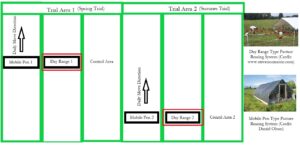 The enclosed style rearing system consists of a 10ft x 15ft hoop style structure outfitted with a bell waterer and gravity and trough feeders and completely contains poultry (no ingress or egress) while providing access to pasture forage, fresh air, and sunlight. The day range rearing system consists of a structure of identical dimension to the enclosed style pen but is open at the base to allow free ingress and egress. Poultry in this system are contained by electrified netting surrounding the structure.
The enclosed style rearing system consists of a 10ft x 15ft hoop style structure outfitted with a bell waterer and gravity and trough feeders and completely contains poultry (no ingress or egress) while providing access to pasture forage, fresh air, and sunlight. The day range rearing system consists of a structure of identical dimension to the enclosed style pen but is open at the base to allow free ingress and egress. Poultry in this system are contained by electrified netting surrounding the structure.
The field for the evaluation is divided into 6 rearing zones. Rearing trials in Zone 1, 2, and 3 occur May 14 - June 6 and are subject to enclosed pen, day range, and control treatments respectively. Rearing trials in Zone 4, 5, and 6 occurred June 8-August 7 and were subject to the same treatments. For each pen treatment, rearing systems were moved to fresh pasture daily with identical initial stocking rates. We used cornish cross broilers sourced from the same local commercial hatchery and raised on pasture from week 3 or 4 to week 8 of life with continuous access to feed and water.
Yield of each rearing system was determined by recording mortalities and their source. Weight of carcasses and major parts will also be recorded upon slaughter.
Pasture impacts will be determined by collecting and analyzing soil samples (following standard NRCS protocols) and vegetation samples from each treatment zone 1 year following rearing. Vegetation will be cut from a standard area at the soil surface, identified, dried, and weighed. Soil samples will be removed from similar locations 1 year following the rearing trials and submitted to an appropriate soil health lab for analysis.
Survival/Predation
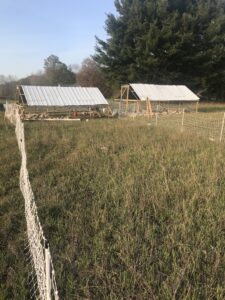 Survival rate was quite different between the two styles of chicken tractor. Of the 96 stocked in each tractor in spring, 80 (83%) survived to harvest in the enclosed chicken tractor while 62 (65%) survived in the day range pen. During the summer trial 111 chicks were stocked in each tractor and 104 (94%) and 81 (73%) survived to harvest in the enclosed and day range tractor, respectively. In other words, survival was substantially higher in the enclosed chicken tractor in both trials.
Survival rate was quite different between the two styles of chicken tractor. Of the 96 stocked in each tractor in spring, 80 (83%) survived to harvest in the enclosed chicken tractor while 62 (65%) survived in the day range pen. During the summer trial 111 chicks were stocked in each tractor and 104 (94%) and 81 (73%) survived to harvest in the enclosed and day range tractor, respectively. In other words, survival was substantially higher in the enclosed chicken tractor in both trials.
Mortality sources were also very different between the tractor styles. During the spring trial, 50 chicks died or were lost some time between the stocking date on May 14 and harvest on June 6. Of these 50, 27 completely vanished (likely due to predation), 19 were lost to confirmed predation, 3 died from unknown causes, and 1 died during the daily tractor move. All chicks that died from confirmed predation were in the day range tractor. 18 of the 19 predation related mortalities were likely due to a real predation (specifically great horned owl). One was lost to during a failure of the electric fence. During the summer trial, 37 chicks died or were lost some time between the stocking date of June 8 and harvest on July 9. Of the 37, 5 vanished (likely predation), 21 died during a storm (hypothermia or crowding), 8 died from likely aerial predation (owl), and 3 died from indiscernible causes. Of the 21 chicks that died during the storm, all but 6 died in the day range tractor. 100% of predator attributed mortality occurred in the day range tractor.
In Summary, chicks in both tractor styles experienced mortality. Survival was much higher in the enclosed chicken tractors relative to the day range style; a storm and predators were the primary cause of chick mortality, The day range style tractor was ineffective at protecting from aerial predation (particularly owls) and less protective of chicks during poor weather conditions.
Yield and carcass characteristics
We saw little difference between the proportional weight of various cuts of chicken from each tractor type. However, overall proportional weights were different than several values we were able to derive from published commercial growers. Enclosed tractors yielded more chicken weight in both spring and summer trials, mostly a result of lower predation rates in the enclosed tractors.
Impacts to the pasture/field (visual)
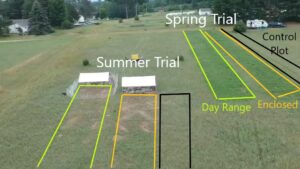 Pastured Poultry trials had immediate visual impact on fallow field. Areas subject to both enclosed and day range rearing styles during May 2021 were revegetated within two months (picture below is from Late June). In each treatment plot, vegetation was darker green and biomass was visibly greater than control plots. Pasture Impact during both spring and summer trials by the chickens was also visibly different between rearing styles. Pasture impact in the day range style appeared less intense and more variable within the plot relative to the enclosed style. Click the following link to view drone footage that captures the study area: IMG_5780
Pastured Poultry trials had immediate visual impact on fallow field. Areas subject to both enclosed and day range rearing styles during May 2021 were revegetated within two months (picture below is from Late June). In each treatment plot, vegetation was darker green and biomass was visibly greater than control plots. Pasture Impact during both spring and summer trials by the chickens was also visibly different between rearing styles. Pasture impact in the day range style appeared less intense and more variable within the plot relative to the enclosed style. Click the following link to view drone footage that captures the study area: IMG_5780
During 2022 and 2023, we continued to visually assess field conditions in the spring and summer trial areas. Vegetative growth was noticeably greater in areas were chicken tractors operated relative to the adjacent control areas during both 2022 and 2023 growing seasons, indicating that the impact of chicken tractors on the field occurs far beyond the year of operation. Grasses appear to be the primary driver of the increased growth with invasive spotted knapweed appearing to have little or no increased growth or abundance. In an adjacent field subject to multiple years of chicken tractor operation, we also observed dominance of field vegetation by grasses and a reduction or, in some cases, complete loss of spotted knapweed from the pasture community. We suspect that chicken activity may give native grasses a competitive edge over non-native knapweed.
Educational & Outreach Activities
Participation Summary:
In May 2021, we posted pictures and background information on the Moshko'Ode Farm Facebook Page and shared it to several larger pastured poultry Facebook groups. The post received 1,061 engagements, 7 shares, and 12 comments.
Throughout 2022 and 2023, we hosted multiple farm tours, spoke with multiple farmers in the region, and shared the results of this project
Learning Outcomes
In conducting this work, we took on (perhaps optimistically) an ambitious project. However, we were able to meet many of the project objectives, evaluate the strengths and weaknesses of two pastured poultry rearing systems, generate highly valuable data for our operation and others. Enclosed pen style poultry rearing systems have several advantages over day range models as they are far more robust for predator control and may better protect birds from predation. It's possible, however, that crowding in these structures reduces growth rates and the need to move the structure every day can be physically taxing and highly problematic if farm laborers are unavailable to do the work. Day range style enclosures require less daily moves and may require less maintenance overall but have substantial weaknesses for predator control and storm protection. These issues might be lessened if other forms of predator control (guard dogs, geese) and weather protection are developed. In the coming year our farm plans to experiment with predator control and attempt to further develop the day range approach into a more viable option. We were able to generate refreshed statistics with regard to the proportional breakdown of pasture raised chicken into relevant cuts and parts. This information has already helped our farm plan for future production years and should be directly applicable to other farmers raising cornish cross broilers on pasture. The impact of raising broilers on pasture in terms of vegetation growth was visibly striking and we continued to observe these impacts during 2022 and 2023. We were unable to complete soil sampling and vegetation sampling as planned owing mostly to COVID-19 pandemic related struggles and the staffing issues thereafter.
We would strongly recommend that other farmers working with pasture raised poultry conduct similar comparisons in rearing styles and pasture impact, particularly in contexts that differ from environmental conditions of rural northern Michigan. We'd recommend that future SARE grant applicant carefully evaluate their proposed workload for a given project and schedule projects during non-pandemic years.
Project Outcomes
Upon completion of this project and visual observation of the experimental plots in the following years, we adopted two major changes to our farm operation. We determined that the enclosed chicken tractor, though less susceptible to predator mortality, resulted in a higher labor cost as a result of requiring daily movement and due to the need for daily feed and water renewal (incorporating larger feed or watering equipment resulted in less space for birds, heavier tractors, and more headaches). The alternative "free-range" rearing system, however, had unacceptably high predation mortality but offered much better potential for scalability with little increase in labor costs. Therefore, we adopted a modified version of the free range model by incorporating guard animals (geese) which substantially reduced predator mortality while preserving nearly all benefits of the free range system.
